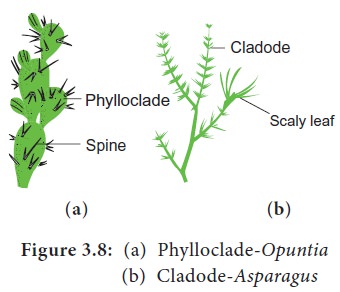Chapter: 11th Botany : Chapter 3 : Vegetative Morphology of Angiosperm
Aerial modification of stem

Aerial modification of stem

1. Creepers
These are plants growing closer (horizontally) to the ground and produces roots at each node. Example: Cynodon dactylon, Oxalis, Centella
2. Trailers (Stragglers)
It is a weak stem that spreads over the surface of the ground without rooting at nodes. They are divided into 3 types,
i. Prostrate (Procumbent): A stem that grows flat on the ground. Example: Evolvulus alsinoides, Indigofera prostrata.
ii. Decumbent: A stem that grows flat but becomes erect during reproductive stage. Example: Portulaca, Tridax, Lindenbergia
iii. Diffuse: Atrailingstemwithspreading branches. Example: Boerhaavia diffusa, Merremia tridentata
3. Climbers
These plants have long weak stem and produce special organs for attachment for climbing over a support. Climbing helps to display the leaves towards sunlight and to position the flower for effective pollination.
i. Root climbers
Plants climbing with the help of adventitious roots (arise from nodes) as in species of Piper betel, Piper nigrum, Hedera helix, Pothos, Hoya.
ii. Stem climbers (twiners)
These climbers lack specialised structure for climbing and the stem itself coils around the support. Example: Ipomoea, Convolvulus, Dolichos, Clitoria, Quisqualis.
Stem climbers may coil around the support clockwise or anti-clockwise. Clockwise coiling climbers are called dextrose. Example: Dioscorea alata. Anti-clockwise coiling climbers are called sinistrose. Example: Dioscorea bulbifera.
iii. Hook climbers
These plants produce specialized hook like structures which are the modification of various organs of the plant. In Artabotrys inflorescence axis is modified into hook. In calamus (curved hook) leaf tip is modified into hook. In Bignonia unguis- cati the leaflets are modified into curved hook (figure: 3.17). In Hugonia the axillary buds modified into hook.
iv. Thorn climbers
Climbing or reclining on the support with the help of thorns as in Bougainvillea and Carissa.
v. Lianas (woody stem climber)
Woody perennial climbers found in tropical forests are lianas. They twine themselves around tall trees to get light. Example: Hiptage benghalensis, Bauhinia vahlii, Entada pursaetha.
vi. Tendril climbers
Tendrils are thread-like coiling structures which help the plants in climbing. Tendrils may be modifications of Stem – as in Passiflora, Vitis and Cissus quadrangularis; Inflorescence axis – Antigonon; Leaf – Lathyrus; Leaflets - Pisum sativum; Petiole – Clematis; Leaftip – Gloriosa; Stipules – Smilax. In pitcher plant (Nepenthes) the midrib of the leaf often coils around a support like a tendril and holds the pitcher in a vertical position.
Phylloclade
This is a green, flattened cylindrical or angled stem or branch of unlimited growth, consisting of a series of nodes and internodes at long or short intervals. Phylloclade is characteristic adaptation of xerophytes where the leaves often fall off early and modified into spines or scales to reduce transpiration. The phylloclade takes over all the functions of leaves, particularly photosynthesis. The phylloclade is also called as cladophyll.
Example: Opuntia, Phyllocactus, Muehlenbeckia (flattened phylloclade) Casuarina, Euphorbia tirucalli, Euphorbia antiquorum (cylindrical phylloclade).

Cladode
Cladode is a flattened or cylindrical stem similar to Phylloclade but with one or two internodes only. Their stem nature is evident by the fact that they bear buds, scales and flowers. Example: Asparagus (cylindrical cladode), Ruscus (flattened Cladode).
Thorns
Thorn is a woody and sharp pointed modified stem. Either the axillary bud or the terminal bud gets modified into thorns. In Carissa apical bud modified into thorns. In Citrus and Atalantia axillary bud is modified into thorns.
Related Topics